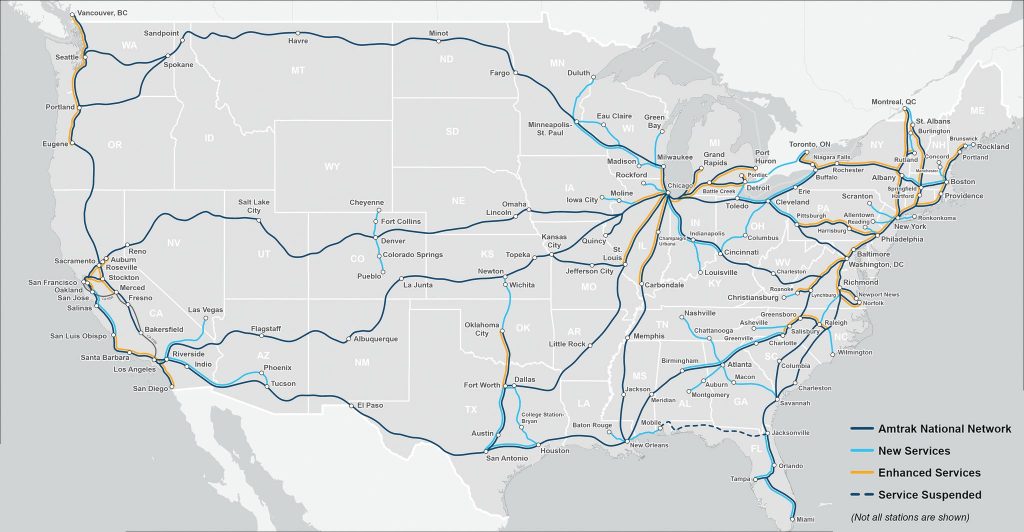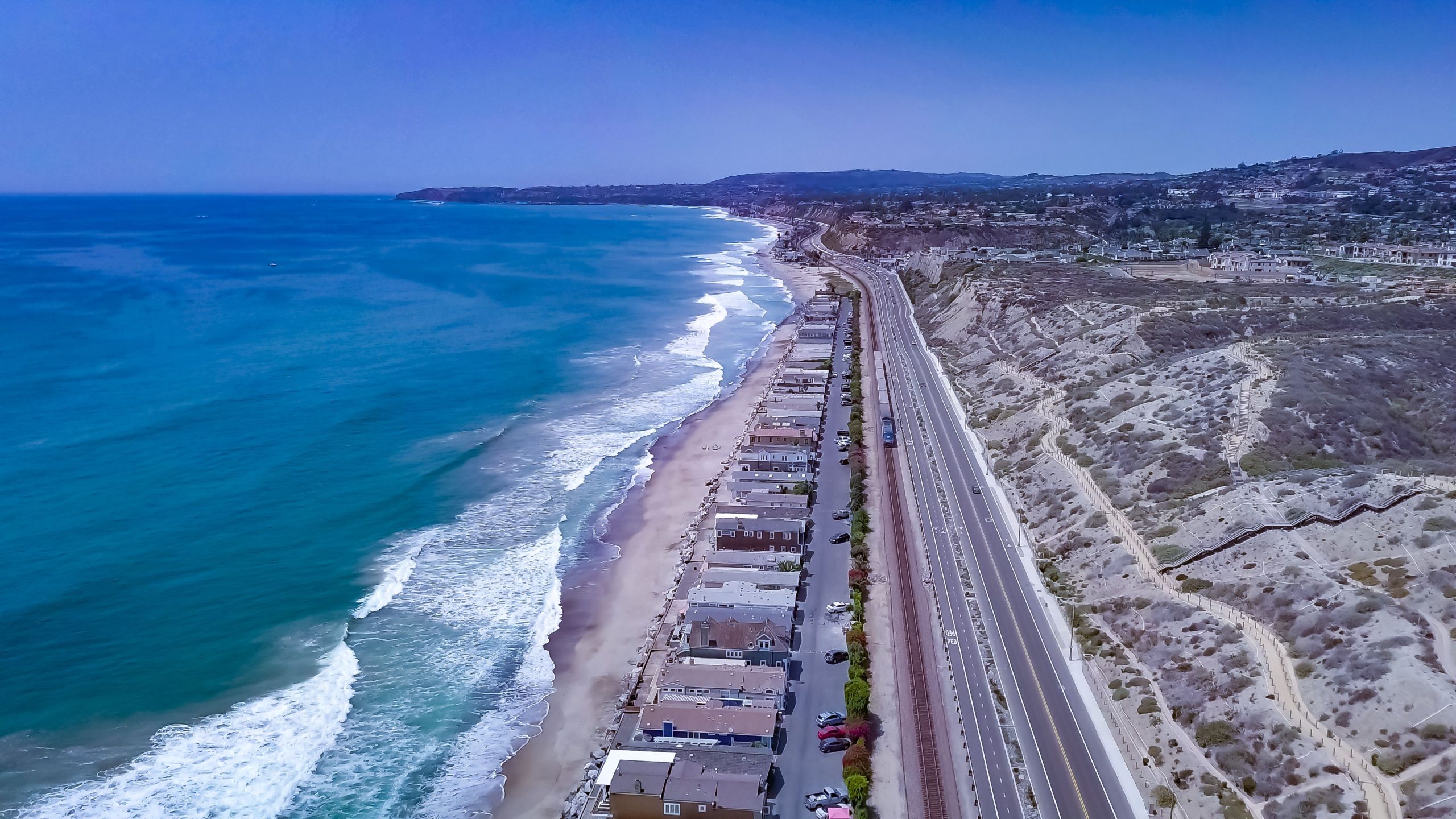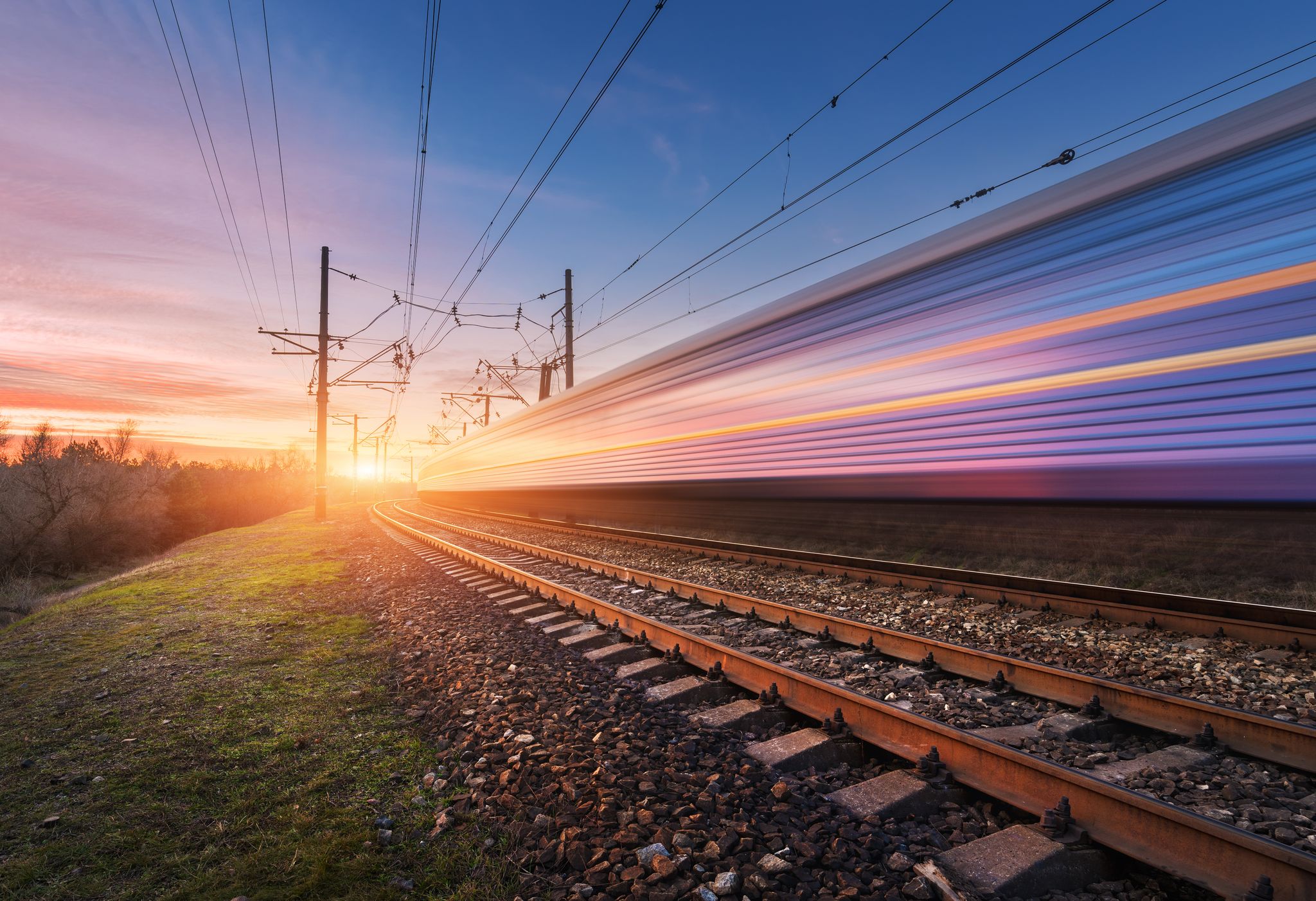Trains are, perhaps, the most romantic mode by which to travel. And in the flurry of COVID-19 vaccines, rising case numbers and social distancing guidelines, train travel might be as alluring as it’s ever been for travelers.
Back in November, I found myself on an Amtrak train from New York City to Trenton, N.J., making my way to New Hope, Pa., to report on a new boutique hotel. I had taken commercial flights during COVID to visit my family back in St. Louis, Mo., and every time, I was a bundle of nerves as I navigated TSA (something that already makes me nervous) and waited to see if my chosen airline would handle social distancing the way they claimed they would (sometimes they did, sometimes they didn’t). So when I arrived at Penn Station to board my train, I had the same airport anxiety, not knowing how this mode of travel that I’ve seldom utilized would handle social distancing guidelines or uphold best practices for health and safety. What I found was a mode of transportation that seemed remarkably up to task in dealing with these challenges. No one was seated next to me, which made me not only feel safe, but also more comfortable, and the trip was filled with much less anxiety than what I felt going through airports.
When I approached Amtrak president Stephen Gardner about how COVID has impacted train travel, he noted: “Amtrak has set a new standard of travel with enhanced safety and cleaning measures. To simplify and safeguard the travel experience, several cleaning, contact-free and convenience measures have been implemented into every part of the customer journey—from time of booking to the moment of arrival. While we introduced these measures due to COVID, we are committed to keeping them in place long after the pandemic is over. At our lowest point in ridership (March 2020), our ridership was down to about three percent what it was before the pandemic. As of mid-April 2021, we are up to about a third of our ridership pre-pandemic. This proves that customers feel safe and confident traveling on Amtrak. Additionally, several of our state-supported trains have returned to service levels seen pre-pandemic due to customer demand.”

But I was curious how others felt about train travel right now, so I reached out to Thomas Pallini, an aviation and transportation reporter for Insider, who has found himself on quite a few train trips during COVID, and he echoed my sentiments.
“All four times that I’ve taken the train, it’s been largely empty,” he said. “So, I didn’t have to worry about someone sitting next to me; I had a whole bunch of open space, way better legroom than any airline could provide in coach. And the thing with Amtrak is that you’re on the ground, but there’s also a lot of ventilation so anytime you walk between a car and that door opens, you get fresh air coming into the cabin, into the car.”
Pallini says that Amtrak has made for a good mode of travel during COVID due to the air quality (or at least how travelers might perceive it) and because of the seating adjustments Amtrak made in light of the pandemic.

“The joke with an airplane is that you’re breathing in recycled air, which isn’t true, but a lot of people still think that,” Pallini said. “Train travel, it doesn’t have the same misconceptions that airline travel does. Amtrak was great because it was blocking adjacent seats, so trains were being sold at 50 percent capacity.”
Back in April, President Joe Biden announced a $2 trillion infrastructure plan, in which $80 billion will be allotted to modernize rail networks, including Amtrak, throughout the U.S. Upon this announcement, Amtrak rolled out a map highlighting what the company plans to have national passenger train routes looking like by 2035.

“The $80 billion proposed for Amtrak and rail is what this nation has been waiting for, but it will require Congress to act and provide Amtrak and our partners with sufficient funding to rebuild and improve the NEC and our National Network and expand our service to more of America,” Gardner said. “Amtrak’s Corridor Vision exemplifies the kind of investments called for in President Biden’s American Jobs Plan—infrastructure investments that will spark economic recovery, help address climate change and advance social equity. Our vision builds upon Amtrak’s national network of long-distance trains, integrating new and improved corridors into our existing system. It is important to note that Congress created Amtrak for this very purpose—to connect America by rail on behalf of the federal government and state partners—and the vision leverages Amtrak’s national capabilities and expertise in place to plan, build and operate these new routes.”
Madison Butler, communications manager for the Rail Passengers Association, said that this proposed plan could be very beneficial to not only the future of Amtrak and train travel, but also for developing more job opportunities.
“Rail Passengers Association had a really pivotal role in founding Amtrak and creating the language around the legislature 50 years ago that brought Amtrak into existence,” Butler said. “So, the team that I work with has extensively, for 50 years, been providing feedback, then working on policy updates to procedures, making sure that accessibility was available in more communities through Amtrak. So, I would say not only just in my experience, but in the longevity of the association, we really have kind of a once-in-a-lifetime opportunity with this $80 billion plan. And while rail is just a part of that, all of these elements are going to tie in together. No new sitting president, since the foundation of Amtrak, has made this bold of a move to develop rail infrastructure, outside of a private capacity. What this infrastructure opportunity does is it allows us to take what has already been done, all the sacrifices that people had to make to create the infrastructure we have and revitalize it in a way that prepares us for the future.”
“I think there are some people who are going to say, ‘well, boy, $80 billion, that’s a lot of money.’ Well, it also is a lot of jobs,” Butler continued. “We’re seeing military people coming home, so many people are going to be brought back from Afghanistan—3,500 people—they’re going to need jobs, and they’re going to need positions that allow for growth. So, as we look at the contrast between regular rail and high-speed rail—these are jobs that are going to be somewhat niche, but also that market is going to continuously expand, real markets will expand, and the demand for passenger rail will expand, and I think it’s really exciting to have leadership that wants to commit to shovel-ready projects.”
According to the Wall Street Journal, Amtrak had been experiencing near historic highs of ridership before the pandemic set in. And Biden’s proposal is a step in the right direction toward helping Amtrak realize this expansion plan, but critics have also pointed out that this wouldn’t be the first time Amtrak has promised expansion and not made good on those promises. When asked about the likelihood of Amtrak’s 2035 map coming to fruition, Butler said it really depends on stakeholders’ commitment to staying involved with the project.
“In the past when there have been expansions, new route proposals, whatever, I think it’s fair to say in a proposal that big and grand that maybe not everything is going to happen, and maybe not everything’s going to happen on that trajectory,” Butler said. “So much can change at a federal or state level with stakeholders, with elected officials, and if they want to have the funding to do this, that funding has to be allocated by Congress to Amtrak. That means constituents, passenger association members, local businesses, community organizations, all need to be involved in saying, ‘we want this for our community,’ and to continue to just hammer at it, and it’s very easy when projects are this big to lose hope. And so, I would say, taking small steps to remain engaged over a long, consistent period of time is the best way to support it. Ultimately, don’t lose hope and don’t lose focus.”
Gardner noted that Amtrak is still not a transportation option in some cities, but that there is a possibility for that to change in the future.
“There are several major cities that do not have any Amtrak service today, including Las Vegas, Nashville, Columbus and Phoenix—an enormous, missed opportunity,” he said. “There are other cities where service is woefully inadequate, like Cincinnati, which is served by Amtrak only three times a week and scheduled to arrive in the middle of the night. There are entire regions with very few Amtrak trains today but where there are city pairs that would benefit from frequent rail service, where we could connect Houston, San Antonio and Dallas/Fort Worth. All of these regions and communities deserve to have a real alternative to driving and flying, and Amtrak has the mandate and the capabilities in place to deliver that future. Development of corridor passenger rail service will also improve mobility for these underserved areas of the country.”
One of Amtrak’s successes has been the Northeast Corridor, allowing travelers to move up and down the Eastern Seaboard easily without getting on a flight and for generally cheaper tickets than airlines. And while Amtrak has long-distance trains running throughout the country, its real strength could lie in the idea of train travel replacing short flights—something France has already voted into effect. In April, France voted to ban all domestic flights that could be reached by passenger trains in under two-and-a-half hours.

Pallini told me he had recently spoken to an expert from the Rail Passengers Association, who had noted that only 10 percent of trips on long-distance lines are taken in full. Rather, train travel is great for traveling between two cities where “flying would be a logistical nightmare.”
“That’s what Amtrak is thinking when it’s adding these lines, that it’ll help under-connected cities get access to larger cities or other small cities, and that’s what Amtrak was founded to do—it’s a government-owned corporation that has the mandate of connecting the U.S. via rail,” Pallini said. “But the thing is that it brings us nowhere near closer to having European-style high-speed rail. It doesn’t enable the existing high-speed Acela line to go any faster than it’s projected to go with the new train sets that are coming online either later this year or next. So, we’re nowhere near where Europe is, where Asia is, in terms of high-speed rail, and we’ve kind of let private companies and individual states create their own lines. Amtrak is still years, if not decades, away from building its own dedicated clean slate high-speed rail with actual high-speed trains that go faster than the Acela can go. So, it’s a great start. It’s great for national rail connectivity. But it’s not going to make Amtrak profitable because long-distance lines are largely money losers.”
But according to Butler, Amtrak’s purpose is not aligned with profitability.
“Amtrak exists as a public service, the same as a library, the same as a post office,” Butler explained. “It’s not meant to create a profit. One of the key reasons that Amtrak exists is to fill a need, and when it was privatized, the private companies historically failed in passenger rail; they did not hit the profit margins that they had projected because it’s not that kind of a service. And it’s more about the community equity, the return on investment to small and big towns that comes from Amtrak. And I think as we see growth, we’ll also see that return on investment.”
As for Gardner, he says that Amtrak is evolving in the aftermath of the pandemic.
“While the pandemic has been tragic for so many people and on so many levels, it has allowed Amtrak to reassess where we are and where we want to be, and [has] allowed us to change the product we offer and consumers we appeal to,” he said. “So as customers continue to return, they will experience a new, reinvented Amtrak, one they are not familiar with. This includes the Moynihan Train Hall in New York City, upgrades we have made on our app, on our trains and at our stations, as well as better pricing. We are also investing in our product by refreshing train interiors and ordering new equipment.”
For more stories from our recent travel issue, check out the digital magazine here.







